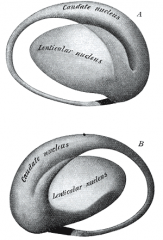![]()
![]()
![]()
Use LEFT and RIGHT arrow keys to navigate between flashcards;
Use UP and DOWN arrow keys to flip the card;
H to show hint;
A reads text to speech;
13 Cards in this Set
- Front
- Back
|
A. Up to 8% of school children suffers from ADHD.
B. Less adults suffer from ADHD, namely about 5%. Which is true? |
Both
|
|
|
How many ADHD patients show comorbidities that persist into adulthood?
|
anywhere from 60 to 100%
|
|
|
Oppositional Defiant disorder and/or conduct disorder occurs in how many of the cases as a comorbidity with ADHD?
|
between 40 and 90%
|
|
|
Only a few children with ADHD show autistic traits.
True or false? |
False.
65-80% show autistic symptoms. |
|
|
How often do problems like dyslexia, dyscalculia, and motor coordination problems occur?
|
between 10 and 50%
|
|
|
Which neurotransmitters are (co)responsible for the symptoms of ADHD? How do these neurotransmitters affect functioning?
|
norepinephrine is lowered, which causes a lower signal strength of the relevant input.
dopamine is lowered, which causes a lowered concentration (less inhibition of 'noise') |
|
|
How can chronic stress have comparable effects to ADHD?
|
Chronic stress drains the amount of norepinephrine and dopamine available, which leads to the same symptoms as in ADHD.
|
|
|
ADHD has a mostly genetic basis.
True or false? |
True. 60-90% is genes.
|
|
|
ADHD patients have lower volumes of gray matter in certain brain areas. Where?
|

They have lower global gray matter, as well as significantly lower gray matter in the right lentiform nucleus (right globus pallidus + putamen).
|
|
|
Aside from lower gray matter volume in certain brain areas, ADHD patients also have GREATER gray matter volume in certain area(s). Which?
|
In the left posterior cingulate cortex / precuneus.
|
|
|
Certain brain areas with an initially lower mass in ADHD patients can increase in volume through two mechanisms. Which areas are these, and through which mechanisms do they increase in mass?
|
Right basal ganglia.
The right putamen increases in size with age. The right caudate nucleus increases in size with extended medication use. |
|
|
What is the main determinant for the severity of comorbidities in ADHD?
|
The severity of the ADHD itself. Stronger ADHD symptoms usually also means stronger comorbid symptoms.
|
|
|
Certain comorbid behavior disorders of ADHD have a genetic component, and seem to be related to executive functioning and motor functioning. Other comorbid behavior disorders don't have this characteristic. Which of the following are genetic in nature?
- autistic traits - anxiety - defiant behavior - motor coordination problems - reading problems |
autistic traits, motor coordination problems and reading problems
|

